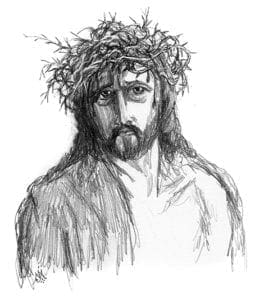Wearing an invisible crown of thorns
By LORRAINE V. MURRAY, Commentary | Published April 9, 2021
Most children remember the first time they plucked a sweet, fluffy rose from the garden and felt the sharp stab of a thorn. It feels like a betrayal, that something so lovely harbors malice.
Jesus talked about people who hear the word of God, but their response is like seed sown on thorny ground. Satan has his way with them and soon the word is choked out by worldly cares and the pursuit of riches.
Later, St. Paul wrote about a mysterious and painful “thorn in the side,” which he saw as coming from Satan.
In the story about Jesus’ passion, the images come fast and furious. The desperate prayers in the garden, the soldiers rushing at him, the poisonous kiss of Judas.
 And then, almost like a moment frozen in time, Jesus is standing in front of the crowd wearing a crown of thorns, which the soldiers made to humiliate him. Like tiny knives, the thorns pierce the head of the Lord of the universe, the one whom Isaiah described as a lamb led to slaughter.
And then, almost like a moment frozen in time, Jesus is standing in front of the crowd wearing a crown of thorns, which the soldiers made to humiliate him. Like tiny knives, the thorns pierce the head of the Lord of the universe, the one whom Isaiah described as a lamb led to slaughter.
There is a beautiful reflection by British author and mystic Caryll Houselander about a life-changing event that happened when she was a little girl in a convent school.
She recalled a Bavarian sister “a tall, gaunt woman with eyes so dark that they looked black,” who couldn’t speak English and was quite lonely.
One day, Caryll walked by a room where the sister was polishing the children’s shoes.
As Caryll drew nearer, she saw that the woman was weeping and tears were splashing on the shoes.
An embarrassed silence followed, during which Caryll looked down at the hands of the weeping woman.
“At last, with an effort I raised my head and then—I saw—the nun was crowned with the crown of thorns,” she writes.
When she told the nun what she had seen, the woman didn’t understand. Then, in a moment of compassion, the little girl sat beside her and helped her polish the shoes.
Reading the Passion story can bring tears and sighs, and shudders of horror, as we see the terrible things that human beings did to God. But if we close the book after Easter and go about our ordinary lives, we’ve missed the point.
“You cannot be at the same time a Christian and a self-complacent egoist,” Father Gerald Vann writes. The voice inside that cries “me” and “mine” must be silenced, as we surrender to something deeper.
So many people are wearing the invisible crown of thorns. They are the parents whose little girl died; the elderly man who lost his wife; the young couple that cannot conceive a child; the cancer patient undergoing painful treatments; the dying woman in the hospital bed.
They are the suffering refugees whose homes and churches have been destroyed; the children who are neglected by their parents; the lonely people in nursing homes.
“Because all men’s sorrows are Christ’s sorrows, we can always find Christ on earth,” Houselander writes.
We try to create a world without thorns, but it’s impossible. We try to do away with physical suffering through medicines, surgeries and therapies—but suffering is built into the fabric of the world.
When Christ encountered suffering people, he was moved to heal them. We may not possess the power of physical healing, but we can attend to the hearts of people in agony. Doing this, however, entails a transformation from selfishness to sacrifice, from me-centered to God-centered.
Let’s pray that once Easter is over, we will see the Christs around us, who wear the crown of thorns. Like the little girl in the convent school, we can sit beside them and share their suffering.
Let’s pray that as we see the Christs around us, we will discover Christ within us.
As St. Paul wrote, “It is not I who live, but Christ who lives in me.”
Artwork is by Jef Murray (www.jefmurray.com). Lorraine’s email address is lorrainevmurray@yahoo.com.